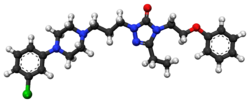 | |
 | |
| Clinical data | |
|---|---|
| Trade names | Serzone, Dutonin, Nefadar, others |
| Other names | BMY-13754-1; MJ-13754-1 |
| AHFS/Drugs.com | Monograph |
| MedlinePlus | a695005 |
| Pregnancy category |
|
| Routes of administration | By mouth |
| Drug class | Antidepressant[1] |
| Legal status | |
| Legal status |
|
| Pharmacokinetic data | |
| Bioavailability | 20% (variable)[2] |
| Protein binding | 99% (loosely)[2] |
| Metabolism | Liver (CYP3A4, CYP2D6)[3] |
| Metabolites | • Hydroxynefazodone[2] • mCPP[2] • p-Hydroxynefazodone[3] • Triazoledione[2] |
| Elimination half-life | • Nefazodone: 2–4 hours[2] • Hydroxynefazodone: 1.5–4 hours[2] • Triazoledione: 18 hours[2] • mCPP: 4–8 hours[2] |
| Excretion | Urine: 55% Feces: 20–30% |
| Identifiers | |
| |
| Chemical and physical data | |
| Formula | C25H32ClN5O2 |
| Molar mass | 470.01 g·mol−1 |
| 3D model (JSmol) | |
| |
| |
| (verify) | |
Nefazodone, sold under various brand names, is a medication primarily used to treat major depressive disorder.[1] Other uses include aggressive behavior and panic disorder.[4] It is taken by mouth.[1]
Common side effects include sleepiness, dry mouth, nausea, constipation, blurry vision, and confusion.[1] Other side effects may include liver problems, suicide, bipolar disorder, seizures, and priapism.[1] Safety in pregnancy is unclear.[5] How it works in not entirely clear but may involved effects on 5-HT and norepinephrine within the brain.[2]
Nefazodone was patented in 1982 and approved for medical use in the United States in 1988.[4][6] It is available as a generic medication.[1] In the United States it costs about 260 USD per month as of 2021.[7] It is no longer commonly used due to concerns with liver problems.[4] It was removed from the market in Europe, Canada, and Australia as of 2004.[8]
References edit
- ^ a b c d e f g h i "Nefazodone Monograph for Professionals". Drugs.com. Archived from the original on 27 February 2021. Retrieved 12 November 2021.
- ^ a b c d e f g h i j Alan F. Schatzberg, M.D.; Charles B. Nemeroff, M.D., Ph.D. (2017). The American Psychiatric Association Publishing Textbook of Psychopharmacology, Fifth Edition. American Psychiatric Pub. pp. 460–. ISBN 978-1-58562-523-9.
{{cite book}}: CS1 maint: multiple names: authors list (link) - ^ a b Gian Maria Pacifici; Olavi Pelkonen (24 May 2001). Interindividual Variability in Human Drug Metabolism. CRC Press. pp. 103–. ISBN 978-0-7484-0864-1. Archived from the original on 6 August 2020. Retrieved 20 October 2021.
- ^ a b c "Nefazodone". LiverTox: Clinical and Research Information on Drug-Induced Liver Injury. National Institute of Diabetes and Digestive and Kidney Diseases. 2012. Archived from the original on 2021-05-06. Retrieved 2021-11-12.
- ^ "Nefazodone (Serzone) Use During Pregnancy". Drugs.com. Archived from the original on 29 November 2020. Retrieved 12 November 2021.
- ^ J. Elks (14 November 2014). The Dictionary of Drugs: Chemical Data: Chemical Data, Structures and Bibliographies. Springer. pp. 857–. ISBN 978-1-4757-2085-3. Archived from the original on 6 August 2020. Retrieved 20 October 2021.
- ^ "Nefazodone Prices, Coupons & Patient Assistance Programs". Drugs.com. Archived from the original on 7 March 2021. Retrieved 12 November 2021.
- ^ Cosgrove-Mather, Bootie (April 15, 2004). "Anti-Depressant Taken Off Market". CBS News. Archived from the original on December 2, 2020. Retrieved October 20, 2021.